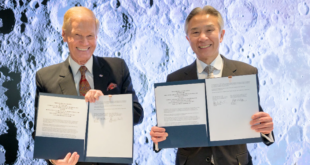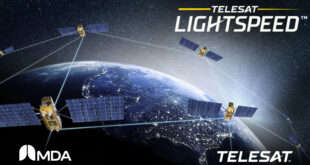
Image courtesy of NASA
Following the executive order on Encouraging International Support for the Recovery and Use of Space Resources signed by President Donald J. Trump on 6 April 2020, it has been reported by Reuters on 5 May 2020 that the United States is drafting principles it proposes can govern mining and other resource extraction operations on the Moon it calls the ‘Artemis Accords’.
The accords are reportedly calling for the establishment of “safety zones” around future Moon bases in order to limit damage and interference by other countries or companies also operating on the Moon. Further, the accords are thought to provide a framework based on the 1967 Outer Space Treaty that will allow companies to own the resources they are able to extract from the Moon.
Reuters reports that the US plans to use the Artemis Accords – named after NASA’s Artemis lunar programme – as the basis for negotiations with like-minded countries such as Japan, Canada, certain European countries like Luxembourg, and the United Arab Emirates. Sources told Reuters that Russia is currently not seen by US officials as a partner any time soon due to ongoing geopolitical tensions between Washington, DC, and Moscow.
In a forthcoming interview about the space resources executive order with SpaceWatch.Global, Dr. Scott Pace, Deputy Assistant to the President and Executive Director of the U.S. National Space Council, said of anticipated Chinese and Russian reactions, “Based on informal discussions at COPUOS and expert working groups, China may be interested in discussions, as it has its own plans for using lunar resources. It’s still a bit early to tell what the official Russian reaction will be after they have time to reflect on the ideas in the EO.”
An unidentified source explained to Reuters the concept and legal rationale for the proposed safety zones in the Artemis Accords. “The idea is if you are going to be coming near someone’s operations, and they’ve declared safety zones around it, then you need to reach out to them in advance, consult and figure out how you can do that safely for everyone,” he said.
The 1967 Outer Space Treaty stipulates that the Moon and other celestial bodies are “not subject to national appropriation by claim of sovereignty, by means of use or occupation, or by any other means.”
The US is adamant that its Moon ambitions, and its “safety zone” concept, do not involve territorial or sovereign claims there. Instead, the idea is that such zones can facilitate coordination and deconfliction between state and corporate actors present on the Moon while at the same time not technically claiming any lunar territory as sovereign.
While SpaceWatch.Global has not seen a copy of the draft Artemis Accords, its existence and proposed international rollout to other so-called like-minded countries suggests that a ‘Lunapoltical’ (the lunar equivalent to geopolitics) agenda will be a part of space policy discussions in the years to come.
 SpaceWatch.Global An independent perspective on space
SpaceWatch.Global An independent perspective on space




